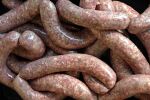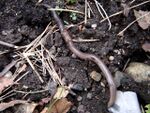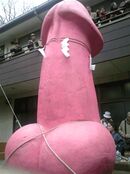Uncyclopedia:Foreign Office/+English/Nematode infections in dogs
| This text does not appear to be entirely English.
Either move it to the appropriate wiki or finish the translation and clean up the prose so it reads proper here. If this page is not fixed in 30 days, it may become a candidate for deletion.
|
|||
A nematode infection is probably the worst scenario a dog owner can imagine. For the dog it is a bad thing too, of course, but it cannot imagine it. (If it can, it probably is no dog but a primate or a cartoon). Nematodes, on the other hand, have a completely different point of view; the dog is not only an adequate nesting place for fairly long periods, even as a short term roost it offers a lot of advantages, particularly compared to the normal house cat, the nile crocodile, or the colibri. The latter is quite unpopular, most nematode counsellors advise against colibris especially due to their small dimensions. Ultimately, a dog's nematode infection - or a nematode's dog infection, respectively – is a serious problem to civilization. Even modern mankind has not yet found an adequate possibility to dispose of nematodes' oddments at all; after all in the most cases even long term dog owners are not sufficiently informed about the hazard of a dog's nematode infection. Particularly this group needs knowledge of this hazard as early as possible, for example by reading this article.
The pin worm itself[edit]
The pin worm (Latin Nematoda, anglified nematode, Polish Nicienie) has a most impressive pedigree that illustrates a long and exciting family history.
The nematode was first reported more than 300 million years before Christ. Of course it was not so well known and feared as it is today. Its first primitive versions eked out a living with odd jobs, worked as assistant earth worms or spaghetti surrogates in Italian dinosaur restaurants. Especially there they caused disgust and soon were treated as the “bottom of the barrel of spineless animals”. Together with some leprous lizards, mentally retarded mites and homosexual brontosaurs they were deported from Pangaea and left alone. The pin worms were the only species that kept afloat even under water. They tried their luck with the ambitious humpback whales where they worked as bowel cleaners. At last some humpback whales developed so far that they could survive on land (some of their descendants are actors in Coronation Street and commentators of sports events today). In this way the pin worms came back on land too and accumulated a good reputation in the area of intestinal flora. Soon they could go shopping in fancy boutiques and visit strip bars again and belonged to the high society.
More than 2 million years before Christ the pin worms almost reached world domination but the Homo sapiens used his technical supremacy to vanquish this high culture and forced it back into the bowels. Since then, the pin worm was tolerated only in humans' and his best friends – the dogs' - guts. Until today.
The dog itself[edit]
The majority of cats claim that dogs are the world’s most primitive animals (of course the enlightened cats among the Uncyclopedia staff don’t). In fact the dog is much more intelligent than the common house snail, Schrödinger's cat or the common Austrian. Of course, the pin worm outwits any dog single-handedly. A nematode never could be forced to wear a tiny plate with its name on it, no, it will not even give itself a name. That avoids a lot of bureaucracy, and the pin worm is a true individualist that doesn’t want to be called out at in a shopping mall by its mistress.
Therefore, such an infection is not really surprising. In the animal world, the same rules as in the human world apply: "If you are not a parasite, you are stupid and will be exploited."
The course of the infection[edit]
Nematodes act intelligently and routinely when they invade the dogs’ guts. Usually it is recommended to cling to the dog's tail while it is sleeping. As soon as the host awakes it will chase its tail as it always does. This time it will find something to catch: the pin worm. Dogs are stupid enough not to chew their food but to swallow it as a whole, so there is no danger for the "prey" of being damaged.
Now the worm ensconces itself in the dog's bowel. Since the human owner offers only the best food to his best friend, like wholesome flakes or protein-rich meat, and himself falls back on fast food and other rubbish, the pin worm lives in the lap of luxury.
Six to eight weeks later, the victim is close to starving. During this time the nematodes perform several segmentations (best and most efficient way of reproduction!) and leave the body. Offspring that dies in this process is useless to the survival of the species anyway – the surviving parasites live happily on in another body.
What to to in case of an infection?[edit]
Advice for dogs[edit]
Your only chance is to assimilate your food to the average human food. If the pin worm dies due to fast food and convenience food overload, you won!
Advice for pet owners[edit]
Why not invite the pin worm into your own body for a weekend. Your advantages:
- Your overfed body can take a break and lose weight, because your new mate eats everything that you stuff into yourself.
- The pin worm will die after not more than three days from all the shit you are eating. Take care when it comes out! The crammed worm could burst during excretion. And don’t drop it in the toilet (it will block it and you’ll have to pay an enormous fine for poisoning the sewers). Instead of this you should dump the pinworm at American Idol or similar programs.
Advice for pin worms[edit]
Carry on! Mankind is so degenerated now, it will not make it much longer. And then there’ll be nothing between you and world domination!
Literature[edit]
- Peter X. Pert: Ankylostomyasis, Trichuriasis und Strongyloidiasis - the nematodic infection of the Canis Lupus Familiaris
- Sasha Pseudo-Professional: Bah, my dog is sick!, Diarrhea publishing


